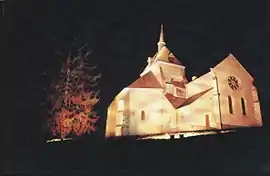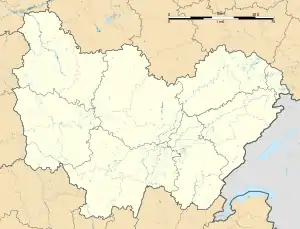Saint-Parize-le-Châtel
Saint-Parize-le-Châtel is a commune in the Nièvre département in central France.
Saint-Parize-le-Châtel | |
|---|---|
 Saint-Patrice Church in Saint-Parize-le-Châtel | |
Location of Saint-Parize-le-Châtel 
| |
 Saint-Parize-le-Châtel  Saint-Parize-le-Châtel | |
| Coordinates: 46°51′18″N 3°10′57″E | |
| Country | France |
| Region | Bourgogne-Franche-Comté |
| Department | Nièvre |
| Arrondissement | Nevers |
| Canton | Saint-Pierre-le-Moûtier |
| Intercommunality | Loire et Allier |
| Government | |
| • Mayor (2014–2020) | André Garcia |
| Area 1 | 49.11 km2 (18.96 sq mi) |
| Population (2017-01-01)[1] | 1,301 |
| • Density | 26/km2 (69/sq mi) |
| Time zone | UTC+01:00 (CET) |
| • Summer (DST) | UTC+02:00 (CEST) |
| INSEE/Postal code | 58260 /58490 |
| Elevation | 180–247 m (591–810 ft) |
| 1 French Land Register data, which excludes lakes, ponds, glaciers > 1 km2 (0.386 sq mi or 247 acres) and river estuaries. | |
The Circuit de Nevers Magny-Cours, a famous motor racing circuit that hosts the Formula One French Grand Prix, is located in the communes of Magny-Cours and Saint-Parize-le-Châtel.
History
The area was evangelised in the 6th century by Patricius (Saint Patrice), a monk after whom the village was named. Before that, the place was known as Gentilico, Gentiliaco or Gentilly.
During the French Revolution, Saint-Parize-le-Châtel was renamed Brenery for some months.
Sights and monuments
- Château de Villars: 14th century castle, parts of which have been listed since 1951 as a monument historique by the French Ministry of Culture.[2]
- Église Saint-Patrice (St Patrick's Church): the 12th century church and its crypt have been listed as a monument historique since 1862.[3]
- Château de la Chasseigne: 15th century manor house.
- Château de Tâche: 16th century hunting lodge
- Château de Lange: fortified house whose origin was a small 12th century castle. The present structure dates from the 15th century.
- Les Fonts-Bouillants: sparkling water springs, exploited commercially between 1895 and 1975.
- Fontaine des vertus: spring in forest, from the same origin as the Fonts-Bouillants. The water is frequently bouillonnante (bubbling), caused by the release of carbon dioxide. According to local legend, Joan of Arc washed her sword in it after liberating Saint-Pierre-le-Moûtier in 1429.
 Crypt of Saint-Patrice Church
Crypt of Saint-Patrice Church Château de Lange
Château de Lange The Fontaine des vertus
The Fontaine des vertus The "Bouillonnements"
The "Bouillonnements"
See also
References
- "Populations légales 2017". INSEE. Retrieved 6 January 2020.
- Base Mérimée: Château de Villars, Ministère français de la Culture. (in French)
- Base Mérimée: Eglise et crypte, Ministère français de la Culture. (in French)
External links
| Wikimedia Commons has media related to Saint-Parize-le-Châtel. |
- INSEE commune file
- Base Mérimée: Château de Villars, Ministère français de la Culture. (in French)
- Base Mérimée: Église Saint-Patrice, Ministère français de la Culture. (in French)
This article is issued from Wikipedia. The text is licensed under Creative Commons - Attribution - Sharealike. Additional terms may apply for the media files.